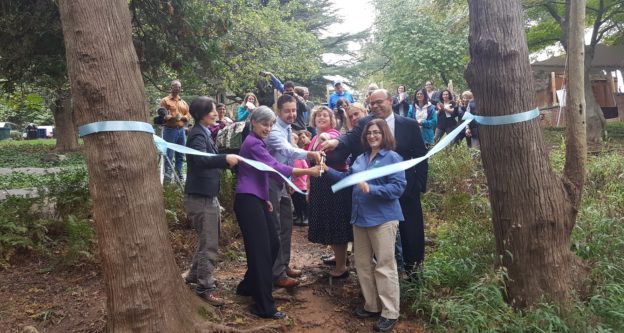Audubon Naturalist Society’s new and innovative tree-safe rain garden reduces flooding and is a model for good environmental living.
Chevy Chase, MD –– How do you help prevent stormwater pollution – the only growing source of pollution to the Chesapeake Bay – and flooding that can lead to home damage? You build a lot of rain gardens, like the innovative “tree-safe” one ANS unveiled today.
ANS’s “tree-safe” rain garden spans 4,000 square, includes more than 300 native trees and shrubs and two lengthy compost-filled berms that will filter and slow polluted stormwater.
“We believe our rain garden is a practical and ecologically powerful thing of beauty,” said ANS Executive Director Lisa Alexander. “We are thrilled that our funding partners, the Chesapeake Bay Trust and the Montgomery County Department of Environmental Protection, enthusiastically supported our vision for a higher level of ecological functioning and biodiversity for our 40 acres here at Woodend. The support they’ve shown us is available as well to our neighbors in the county and region.”
“The Chesapeake Bay Trust is proud to combine forces with funding partners like Montgomery County Department of Environmental Protection and the United States Environmental Protection Agency (EPA) to provide the necessary resources to green and beautify neighborhoods, community spaces, and improve local waterways.” said Dr. Jana Davis, executive director of the Chesapeake Bay Trust. “Projects such as the tree-safe rain garden completed at the Audubon Naturalist Society are the perfect example at solving water quality issues while providing a space for community education and outreach.”
ANS’s Conservation Director, Eliza Cava, explained why “tree-safe” was a conscious and environmentally-friendly choice for this rain garden. “Washington, D.C. and other major cities have used rain gardens for years to help manage polluted stormwater runoff. We, at ANS, chose a tree-safe rain garden because its design is cutting-edge and tree-friendly,” said Cava, “and that’s important because trees are the very best way to manage stormwater because they absorb so much water and hold the soil in place.”
“The tree-safe rain garden is an excellent example of how ANS implements unique, sustainable, projects that help manage stormwater within the constraints of a challenging, historic, site,” said Michelle Kokolis, director of Programs and Operations, Rock Creek Conservancy. “This garden, and projects like it, are essential to the health of Rock Creek and the watershed. Rock Creek Conservancy is happy to have the opportunity to partner with ANS on such projects and looks forward to our continuing collaboration.”
How rain gardens help
After a hard rain, many areas flood because they’re covered with pavement that can’t absorb the excess water. That standing water collects debris, oil, fertilizer, and other dirty, often toxic, stuff and “whooshes” down streets, causing problems like pollution and erosion to our roads, homes, businesses, rivers and streams. Rain gardens capture the rain shortly after it falls, before it wreaks havoc, and recycle it in a way that doesn’t harm the human and natural community.
Aren’t trees already safe in rain gardens?
Unlike traditional rain gardens, which capture rain runoff in deep pits filled with gravel, our innovative tree-safe rain garden holds the water above ground in temporary ponds. By using this technology, we didn’t have to dig underground and disturb mature tree roots.
During the unveiling, guests saw firsthand how the tree-safe rain garden works, and how homeowners and institutions can use elements of its design in their own yards to manage runoff.
“This project shows that trees and rain gardens go well together,” said Diane Cameron, Project Manager, and former Director of Conservation for ANS. “We encourage our neighbors, including churches and temples, along with private homeowners, to follow suit on their own lands by planting more trees, keeping the trees they now have, and building rain gardens wherever that makes sense.”
Homeowners can get money to build rain gardens
Most of the counties and cities in our region also provide financial incentives – rebates worth hundreds or even thousands of dollars – to homeowners and institutions who install certain types of rain gardens and other projects to manage polluted runoff.
What: Woodend Tree-Safe Rain Garden Ribbon Cutting
Date: October 13, 2017
Time: 10:00 am – 11:30 am
Location: Woodend Sanctuary, 8940 Jones Mill Road, Chevy Chase, MD 20815
Funding for the tree-safe rain garden was provided through the Montgomery County Water Quality Protection Fund, EPA Region 3 and the Chesapeake Bay Trust. Other funders include the Wallace Genetic Foundation and the Cornell Douglas Foundation. The rain garden was designed by the Center for Watershed Protection and installed by Environmental Quality Resources, LLC.
For more information contact [email protected] or call 301-652-9188 x 23
# # #
About ANS: ANS is the oldest, independent environmental organization in the DMV. Throughout its history, ANS has played a pivotal role in conserving our region’s iconic natural places from development including the C&O Canal, Dyke Marsh and most recently Ten Mile Creek. Past ANS member and board president, Rachel Carson, author of Silent Spring, is credited with launching the now global environmental movement. ANS’s nature experts provide hundreds of opportunities each year for children and adults to enjoy, learn about, and protect the environment.
Learn more about ANS here: www.anshome.org, www.Facebook.com/Audubon Naturalist SocietyNaturalistSociety, and www.Twitter.com/ANStweets

